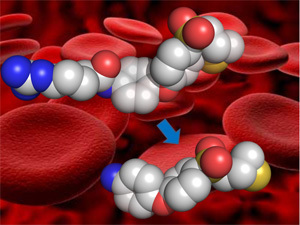
Results of a study by a group of University of Notre Dame researchers represent a promising step on the road to developing new drugs for a variety of neurological diseases.
The group from the University’s Departments of Chemistry and Biochemistry and Biological Sciences and the Freimann Life Sciences Center focused on the design, synthesis and evaluation of water-soluble “gelatinase inhibitor” compounds.
Gelatinases, a class of enzymes, have been implicated in a host of human diseases from cancer to cardiovascular conditions and in particular neurological conditions such as stroke, aneurysm and traumatic brain injury. Researchers have increasingly focused on developing potent gelatinase inhibitor drugs to treat acute gelatinase-dependent diseases.
The Notre Dame group has been investigating variants of a compound called “SB-3CT,” which shows promise as a selective and potent gelatinase inhibitor. SB-3CT has exhibited potent efficacy in animal models for a variety of neurological and cancer diseases.
The preferred method of treatment for acute gelatinase-dependent diseases is intravenous infusion. Intravenous administration requires that the compound be water soluble. Unfortunately SB-3CT has poor water solubility and poor drug-like properties.
In a new approach, the Notre Dame researchers used a prodrug strategy to address this issue. A prodrug is an inactive precursor of a drug that is converted into its active form in the body by normal metabolic processes.
The prodrug strategy produced a greater than 5,000-fold increase in water solubility compared to SB-3CT. In addition to its high water solubility, the prodrug (referred to as ND-478) was chemically stable, non-toxic and was quickly converted to the active drug in the blood. These favorable properties of ND-478 make it suitable for intravenous administration in the treatment of acute gelatinase-dependent diseases. Such a compound offers the possibility of translation into the clinic for treatment of strokes, aneurysms and traumatic brain injury.
The Notre Dame research team included Mayland Chang, Shahriar Mobashery, Major Gooyit, Mijoon Lee, Valerie A. Schroeder, Masahiro Ikerjiri and Mark Suckow. Their paper appears in the Journal of Medical Chemistry.
Contact: Mayland Chang, 574-631-2965, mchang@nd.edu